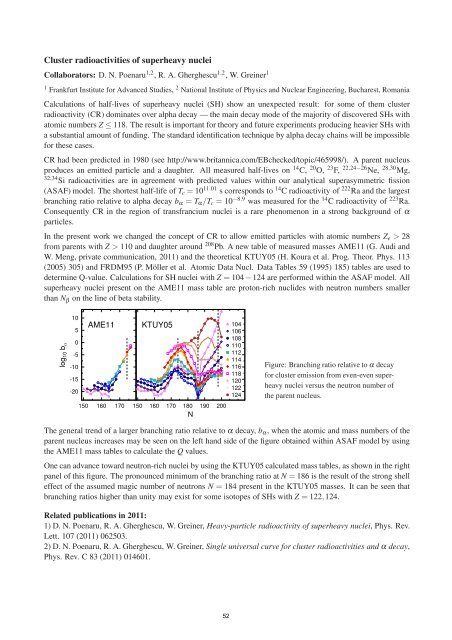FIAS Scientific Report 2011 - Frankfurt Institute for Advanced Studies ...
FIAS Scientific Report 2011 - Frankfurt Institute for Advanced Studies ...
FIAS Scientific Report 2011 - Frankfurt Institute for Advanced Studies ...
You also want an ePaper? Increase the reach of your titles
YUMPU automatically turns print PDFs into web optimized ePapers that Google loves.
Cluster radioactivities of superheavy nuclei<br />
Collaborators: D. N. Poenaru 1,2 , R. A. Gherghescu 1,2 , W. Greiner 1<br />
1 <strong>Frankfurt</strong> <strong>Institute</strong> <strong>for</strong> <strong>Advanced</strong> <strong>Studies</strong>, 2 National <strong>Institute</strong> of Physics and Nuclear Engineering, Bucharest, Romania<br />
Calculations of half-lives of superheavy nuclei (SH) show an unexpected result: <strong>for</strong> some of them cluster<br />
radioactivity (CR) dominates over alpha decay — the main decay mode of the majority of discovered SHs with<br />
atomic numbers Z ≤ 118. The result is important <strong>for</strong> theory and future experiments producing heavier SHs with<br />
a substantial amount of funding. The standard identification technique by alpha decay chains will be impossible<br />
<strong>for</strong> these cases.<br />
CR had been predicted in 1980 (see http://www.britannica.com/EBchecked/topic/465998/). A parent nucleus<br />
produces an emitted particle and a daughter. All measured half-lives on 14 C, 20 O, 23 F, 22,24−26 Ne, 28,30 Mg,<br />
32,34 Si radioactivities are in agreement with predicted values within our analytical superasymmetric fission<br />
(ASAF) model. The shortest half-life of Tc = 10 11.01 s corresponds to 14 C radioactivity of 222 Ra and the largest<br />
branching ratio relative to alpha decay bα = Tα/Tc = 10 −8.9 was measured <strong>for</strong> the 14 C radioactivity of 223 Ra.<br />
Consequently CR in the region of transfrancium nuclei is a rare phenomenon in a strong background of α<br />
particles.<br />
In the present work we changed the concept of CR to allow emitted particles with atomic numbers Ze > 28<br />
from parents with Z > 110 and daughter around 208 Pb. A new table of measured masses AME11 (G. Audi and<br />
W. Meng, private communication, <strong>2011</strong>) and the theoretical KTUY05 (H. Koura et al. Prog. Theor. Phys. 113<br />
(2005) 305) and FRDM95 (P. Möller et al. Atomic Data Nucl. Data Tables 59 (1995) 185) tables are used to<br />
determine Q-value. Calculations <strong>for</strong> SH nuclei with Z = 104 − 124 are per<strong>for</strong>med within the ASAF model. All<br />
superheavy nuclei present on the AME11 mass table are proton-rich nuclides with neutron numbers smaller<br />
than N β on the line of beta stability.<br />
log 10 b<br />
10<br />
5<br />
0<br />
-5<br />
-10<br />
-15<br />
-20<br />
AME11 KTUY05<br />
150 160 170 150 160 170 180 190 200<br />
N<br />
104<br />
106<br />
108<br />
110<br />
112<br />
114<br />
116<br />
118<br />
120<br />
122<br />
124<br />
Figure: Branching ratio relative to α decay<br />
<strong>for</strong> cluster emission from even-even superheavy<br />
nuclei versus the neutron number of<br />
the parent nucleus.<br />
The general trend of a larger branching ratio relative to α decay, bα, when the atomic and mass numbers of the<br />
parent nucleus increases may be seen on the left hand side of the figure obtained within ASAF model by using<br />
the AME11 mass tables to calculate the Q values.<br />
One can advance toward neutron-rich nuclei by using the KTUY05 calculated mass tables, as shown in the right<br />
panel of this figure. The pronounced minimum of the branching ratio at N = 186 is the result of the strong shell<br />
effect of the assumed magic number of neutrons N = 184 present in the KTUY05 masses. It can be seen that<br />
branching ratios higher than unity may exist <strong>for</strong> some isotopes of SHs with Z = 122,124.<br />
Related publications in <strong>2011</strong>:<br />
1) D. N. Poenaru, R. A. Gherghescu, W. Greiner, Heavy-particle radioactivity of superheavy nuclei, Phys. Rev.<br />
Lett. 107 (<strong>2011</strong>) 062503.<br />
2) D. N. Poenaru, R. A. Gherghescu, W. Greiner, Single universal curve <strong>for</strong> cluster radioactivities and α decay,<br />
Phys. Rev. C 83 (<strong>2011</strong>) 014601.<br />
52
















